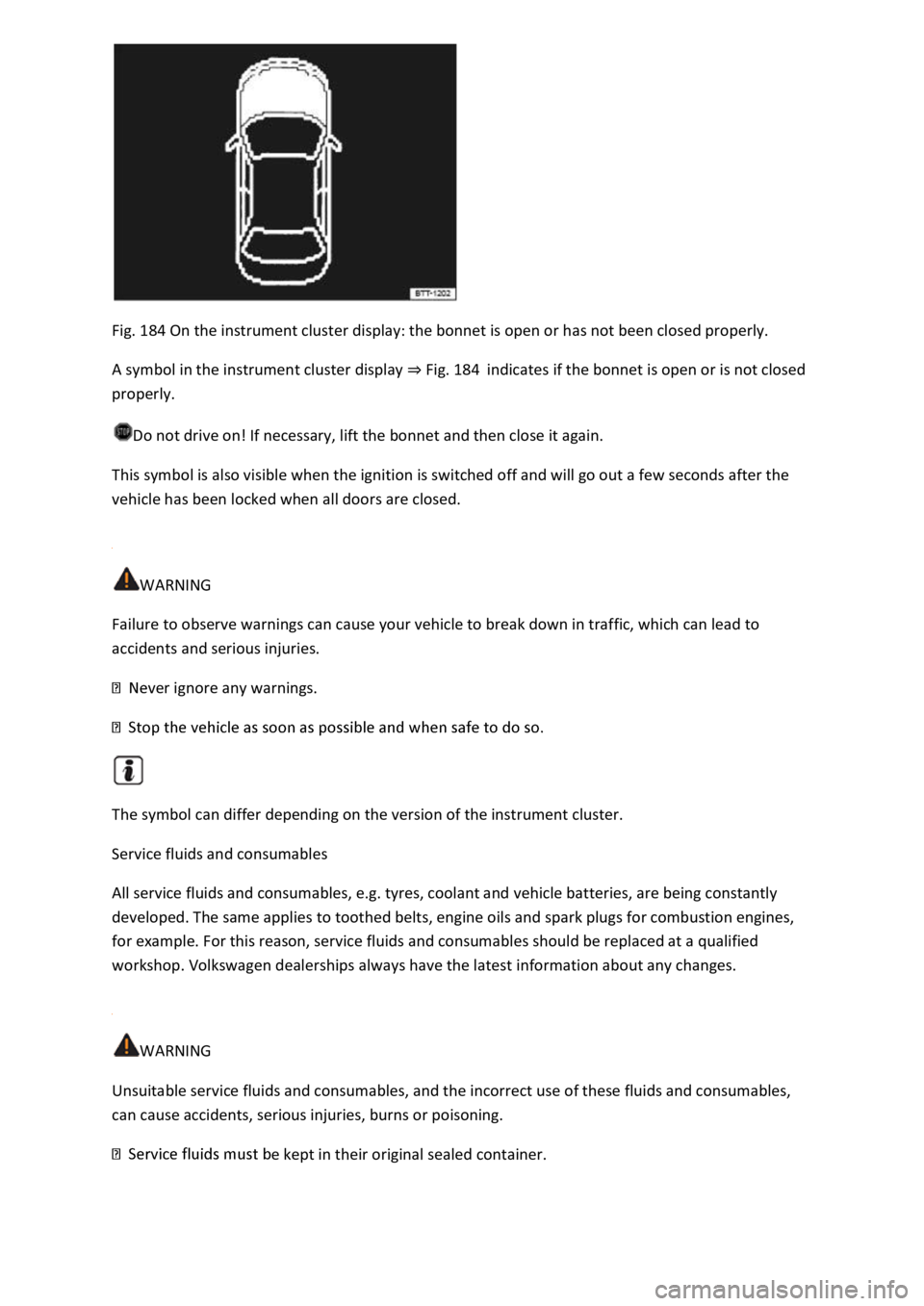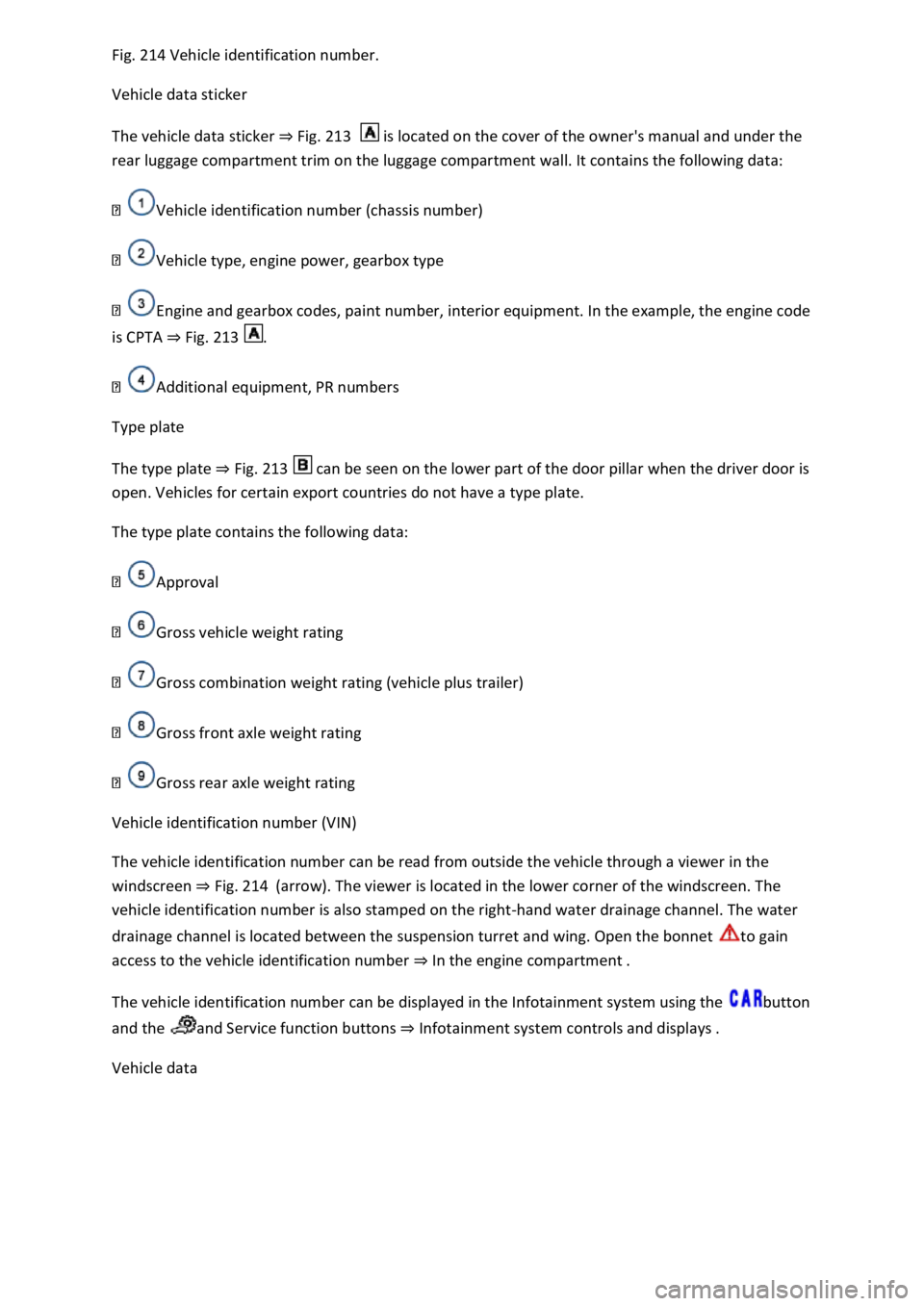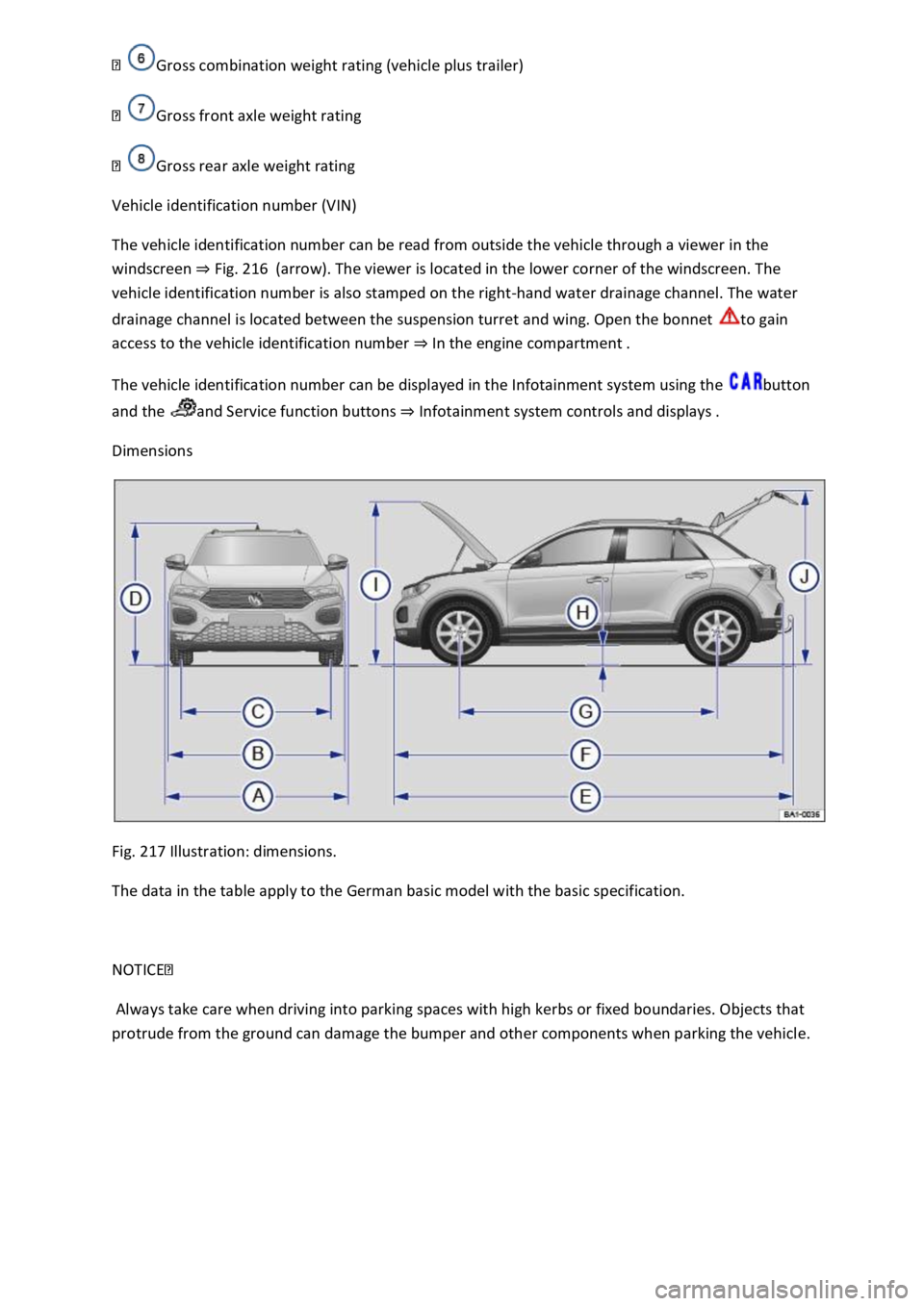Page 368 of 502

Fig. 184 On the instrument cluster display: the bonnet is open or has not been closed properly.
A symbol in the instrument cluster display Fig. 184indicates if the bonnet is open or is not closed
properly.
Do not drive on! If necessary, lift the bonnet and then close it again.
This symbol is also visible when the ignition is switched off and will go out a few seconds after the
vehicle has been locked when all doors are closed.
WARNING
Failure to observe warnings can cause your vehicle to break down in traffic, which can lead to
accidents and serious injuries.
ver ignore any warnings.
The symbol can differ depending on the version of the instrument cluster.
Service fluids and consumables
All service fluids and consumables, e.g. tyres, coolant and vehicle batteries, are being constantly
developed. The same applies to toothed belts, engine oils and spark plugs for combustion engines,
for example. For this reason, service fluids and consumables should be replaced at a qualified
workshop. Volkswagen dealerships always have the latest information about any changes.
WARNING
Unsuitable service fluids and consumables, and the incorrect use of these fluids and consumables,
can cause accidents, serious injuries, burns or poisoning.
e kept in their original sealed container.
Page 375 of 502

With the engine at operating temperature, park the vehicle on a level surface to ensure that the
engine oil reading is correct.
Switch off the engine and wait a few minutes for the engine oil to flow back into the sump.
Open the bonnet In the engine compartment.
Identify the engine oil filler cap and oil dipstick. The engine oil filler opening can be recognised by
the symbol on the cap and the oil dipstick has a coloured handle. If you cannot find the cap and
dipstick, please contact a qualified workshop.
Pull the dipstick out of the guide tube and wipe it off with a clean cloth.
Insert the oil dipstick into the guide tube again as far as it will go. If there is a marking on the upper
end of the oil dipstick, this marking must fit into the corresponding groove at the top end of the
guide tube upon insertion.
Engine oil
level too high. Observe any messages that are shown on the instrument cluster display or contact a
qualified workshop . Do not fill any engine oil . Continue with step 16. Engine oil level OK.
Engine oil can, e.g. in the case of high engine loads , be filled up to the upper limit of this range.
Continue with step 8 or 16. Engine oil level is too low. Engine oil must be filled. Continue with
step 8.
After reading off the oil level, push the oil dipstick back into the guide tube as far as it will go.
Unscrew the cap of the engine oil filler opening .
Using only the engine oil approved by Volkswagen expressly for this engine, fill oil gradually in small
amounts (no more than 0.5 l).
Page 376 of 502

engine oil to flow into the sump up to the marking on the engine oil dipstick.
Read the engine oil level from the dipstick again before refilling with a further small quantity of
engine oil. Never overfill engine oil .
After refilling, the engine oil level should be in the middle of area
area nd must not be in area .
If too much engine oil has been added unintentionally and the engine oil level is in area
start the engine. Inform a qualified workshop and seek expert assistance if necessary.
Close the engine oil filler opening with the cap after filling.
Insert the oil dipstick into the guide tube as far as it will go. If there is a marking on the upper end of
the oil dipstick, this marking must fit into the corresponding groove at the top end of the guide tube
upon insertion.
Close the bonnet In the engine compartment.
WARNING
Engine oil can ignite if it comes into contact with hot engine components. It can cause fires, burns
and other serious injuries.
up and ignite when the engine is running.
dipstick is properly inserted back into the guide tube. This will prevent the engine oil from draining
out on to hot engine components when the engine is running.
NOTICE
Fig. 186
necessary. The catalytic converter and the engine could otherwise be damaged.
Page 381 of 502
drive on. Seek professional assistance.
level remains stable.
Fig. 188
fill up above the top edge of the marked area
Coolant
specificationled water
only. Then add the correct proportion of the specified coolant additive as soon as possible
Coolant specification
WARNING
Hot steam and hot coolant can cause serious burns.
coolant coming out of the engine
compartment. Always wait until you can no longer see or hear escaping steam or coolant.
components can burn the skin.
wing points must be observed before opening the bonnet once it has cooled down:
P or move the gear
lever to the neutral position.
hicle key from the ignition lock.
unattended.
expansion tank when the engine is hot. Coolant may spray out and cause serious burns and other
injuries.
-clockwise while exerting gentle downward pressure on
the cap.
with a large, thick cloth.
spilt service fluids can start a fire. In certain circumstances, the ethylene glycol in the coolant can
catch fire.
NOTICE
Page 488 of 502

214 Vehicle identification number.
Vehicle data sticker
The vehicle data sticker Fig. 213 is located on the cover of the owner's manual and under the
rear luggage compartment trim on the luggage compartment wall. It contains the following data:
Vehicle identification number (chassis number)
Vehicle type, engine power, gearbox type
Engine and gearbox codes, paint number, interior equipment. In the example, the engine code
is CPTA Fig. 213
Additional equipment, PR numbers
Type plate
The type plate Fig. 213can be seen on the lower part of the door pillar when the driver door is
open. Vehicles for certain export countries do not have a type plate.
The type plate contains the following data:
Approval
Gross vehicle weight rating
Gross combination weight rating (vehicle plus trailer)
Gross front axle weight rating
Gross rear axle weight rating
Vehicle identification number (VIN)
The vehicle identification number can be read from outside the vehicle through a viewer in the
windscreen Fig. 214(arrow). The viewer is located in the lower corner of the windscreen. The
vehicle identification number is also stamped on the right-hand water drainage channel. The water
drainage channel is located between the suspension turret and wing. Open the bonnet to gain
access to the vehicle identification number In the engine compartment
The vehicle identification number can be displayed in the Infotainment system using the button
and the and Service function buttons Infotainment system controls and displays
Vehicle data
Page 490 of 502

Gross front axle weight rating
Gross rear axle weight rating
Vehicle identification number (VIN)
The vehicle identification number can be read from outside the vehicle through a viewer in the
windscreen Fig. 216(arrow). The viewer is located in the lower corner of the windscreen. The
vehicle identification number is also stamped on the right-hand water drainage channel. The water
drainage channel is located between the suspension turret and wing. Open the bonnet to gain
access to the vehicle identification number In the engine compartment
The vehicle identification number can be displayed in the Infotainment system using the button
and the and Service function buttons Infotainment system controls and displays
Dimensions
Fig. 217 Illustration: dimensions.
The data in the table apply to the German basic model with the basic specification.
NOTICE
Always take care when driving into parking spaces with high kerbs or fixed boundaries. Objects that
protrude from the ground can damage the bumper and other components when parking the vehicle.